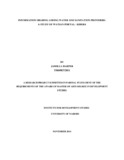| dc.description.abstract | As informal water and sanitation services grow, understanding how informal water and
sanitation providers share and seek information throughout informal settlements becomes of
increasing importance in understanding how to support these actors in helping the Government
of Kenya to meet their Constitutional mandate of adequate water and sanitation for all. This
study investigates the ways in which the emerging information communication technology of
WATSAN Portal: Kibera assists water and sanitation providers in planning and implementing
improved Projects.
This research applies qualitative methodological approaches to understand the advantages and
barriers to the use of WATSAN Portal. Qualitative desktop review identified and analysed
information shared through the Portal. In identifying the information provided by the Portal, this
study reviewed the content within this website in a first phase of research. The study applies
desktop review to determine what information is shared through the Portal and how it enhances
information sharing among water and sanitation providers. In the second phase of this research,
four key Users of the Portal and nine other water and sanitation Providers in Kibera were
selected to participate in-depth interviews to uncover characteristics of Portal Users, the types of
water and sanitation information shared and sought, and the advantages and challenges to
information sharing through the Portal. Combined, the study of the Portal, the Users, and other
select Providers provides an understanding how new information communication technology
supports water and sanitation development in Kibera.
The study found that the information aids Users of the Portal in rapid information-gathering,
information-sharing, and preliminary planning of water and sanitation projects. However, the
technical and infrastructural challenges of NCWSC sometimes limits the presence of practical,
functional information in the Portal. This barrier in information-sharing hinders outcomes,
including: the ability of this Portal to alter relationships between water and sanitation providers
and municipal authorities, and the improvement of how Providers and residents make decisions
about project implementation. To this end, the study recommends municipal and County
government include, engage, and support water and sanitation providers as essential to meeting
water and sanitation demand. Additionally, this study recommends that the developers of the
WATSAN Portal should explore alternative information communication technology that
increases the accessibility of the information contained within the Portal to water and sanitation
providers who have limited computer and Internet access. | en_US |

